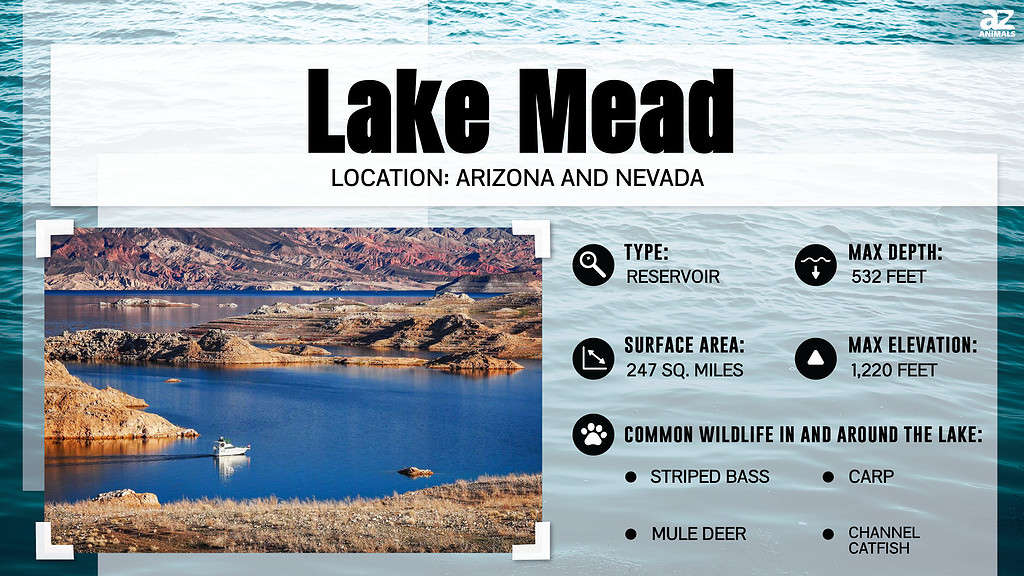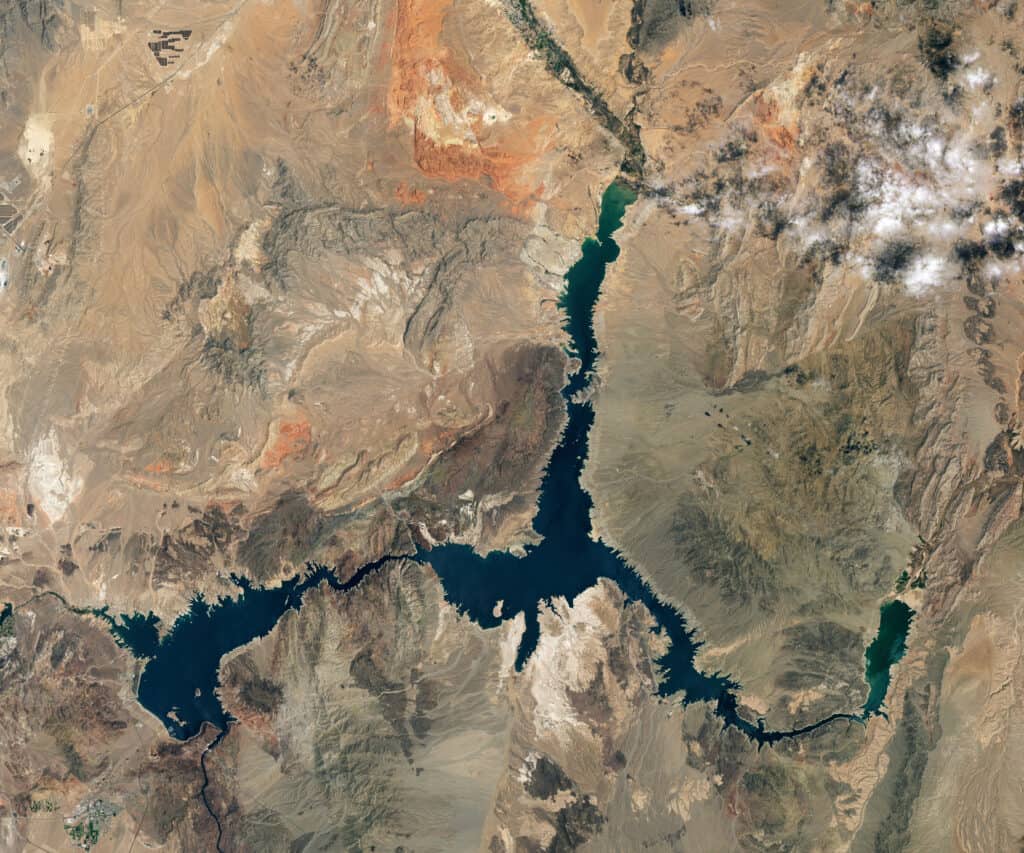You must have heard about the chaos going on at Lake Mead. It is genuinely devastating but even more frustrating that the country cannot do much about it. The damage is quite already done. Or is it? Don’t worry; we will get to that.
If you are unaware of the situation at the lake, let us give you a small brief first. The lake is suffering from extreme drought. The water levels currently recorded in Lake Mead have broken a decade-old record. So, it is scary. But what made this situation rise? Whether it is in control now is something we will discuss in this article.
In the blog, you will find what is happening at Lake Mead, whether it will be fixed, and what could happen if the lake dries up. On top of that, could this be the start of a potential water crisis in the West?
Without further ado, let’s dive in and answer your questions!

What is Currently Happening at Lake Mead?
Lake Mead is a popular tourist site and a famous attraction for boat enthusiasts. But this unfortunate situation has left many people surprised.
In the summer season, a lot of people came with boats to the shore of Lake Mead. They were forced to return when there was a warning sign of low water levels. Families have been coming here for decades, but they had to halt their plans because the sailing posed a severe danger.
In June, Lake Mead faced one of its most challenging seasons. The water level dropped below 1,049 feet (319.7 meters).
If you want a bit of context, the lake has never seen such a level drop. This is the first time that the levels dropped below 1,050 feet. The highest water level ever recorded was around 1,225 feet. In comparison, there is a significant 15% decrease due to a drought of more than twenty years.
Here is the biggest problem. Some people were persistent in going to the lake and found their cars stuck in the sand. So, what happened was that the low water levels quickly turned the sand into mud.
The shores that allowed people to transfer their boats are now filled with quicksand. It is not your standard mud, but the sand that has been underwater for decades, making it a dreadful site for driving. Even the tow trucks called for help got stuck in this muddy situation. So basically, the picnic is now to get stuck at the shore. Or worse, drown in the quicksand.
This isn’t even the worst part. The low water levels mean that you cannot entirely navigate the shore. Hence, you will lose your path when you bring in vehicles and accessories. You cannot just stop at a point and think that this is the farthest you can go because you won’t know the line where the shore becomes quicksand.
What Brought a Drought to Lake Mead?
Unfortunately, what Lake Mead is going through now is the result of climate change. Of course, there are other factors involved, like population growth, but the way that global warming has affected this area is not something to ignore.
The seasons today are pretty unpredictable; one of the most challenging drought seasons captured Lake Mead in its unlucky grip, turning it dry. A 170-foot drop hasn’t been recorded since 2000, when the drought began. Yet, even with the recent rainfalls, the lake still covers a capacity of 27%.

©NASA Earth Observatory images by Joshua Stevens, using Landsat data from the U.S. Geological Survey / Public domain, from Wikimedia Commons, the free media repository – License
What Happens if Lake Mead Dries Up?
If you compare the images of Lake Mead from years ago to how it currently is, you would be in shock. There is a clear difference and a visible representation of how the drought has changed the lake’s situation. You will also find boats on dry lake beds, yellow vegetation, and low water levels in the form of rings near reservoirs.
Painting that picture in your head, read this. Lake Mead currently transports drinking water to more than 25 million people in Arizona, Nevada, California, and Mexico. They all are significant places for the agricultural industry of the US. But unfortunately, these areas have been water cuts due to the drastic fall in the lake’s water levels. And you will see a significant change in the agricultural industry’s progress due to these cuts.
But currently, the situation is not all bad. If they were to worsen, these agricultural lands, the main food supply of the country, would witness even more water cuts. This will eventually lead to a lesser food supply in the future.
That’s not all. The reservoir is the primary hydroelectric source for Lake Powell’s dam. It provides electricity to more than 29 million people in the country’s Southwestern part. So if this lake dries up, it is not just the food supply that will falter. But there might be an electricity crisis in the state too. That would eventually create many other problems around the country with migration, increased housing demand, and much more.
However, the situation is not that bad at the moment. But Lake Mead remains an essential resource to the country. Therefore, whatever the facts are today, it needs proper observation in the upcoming years.
Is There Anything Being Done About Lake Mead?
Lake Mead eventually provides a source for Lake Powell. The government intends to fill Lake Powell by transitioning water from reservoirs on the Colorado River. Around 7.48 million acre-feet of water were released from Glen Canyon Dam to Lake Mead.
This may be a temporary solution because the hydroelectric dam is trying to extract an amount of water that the lakes cannot provide. However, the state is trying to keep an observant eye on the crisis. With unpredictable seasons, it is hard to define a motive beforehand. So, even the state can only prepare for what’s coming.
Now, one could argue that water cuts could fix the situation. But, experts believe that, with the number of water cuts, Lake Mead will eventually keep needing more. The reason is that the water cuts taken today are pretty unsatisfactory. They are trying to help the cities that get water from Lake Mead while saving Lake Mead from the drought. But the demand keeps increasing. Therefore, even drastic measures of high water cuts planned in the future could not be enough to save Lake Mead. This is unless the agencies aim for more than the stages of water cuts scheduled for 2023.
Another fundamental issue is that the people cannot specify the demand and supply of water from Lake Mead. This creates a significant problem because if you cannot figure out the balance to save the lake, there will be no lake to hold. Even with water cuts, the demand and water use keep increasing. With this in mind, the right policies could alter the fate of Lake Mead.
Is This the Start of a Water Crisis in the West?
Lake Mead is not expected to recover soon. The water levels are projected to quickly drop to 1,037 feet (316.07 meters) near the fall season. On top of that, by September 2023, the water level will be 19% of the lake’s total capacity, which currently stands at 27% of the full capacity.
With the scarce food supply and the potential energy problems, we are looking at a drastic situation in the future. Plus, the drought that has encountered Lake Mead is not just a drought but a megadrought that has lasted for two decades. In addition, the lake has been the driest for 1,200 years. The facts are, no doubt, quite scary.
Plus, there is an expected increase in global energy prices. With these prices already at a 50% high, such a situation could make this rate even higher. So, there is no denying that we are looking at troubled times. However, the time for a potential crisis cannot be predicted. If things are handled right, such issues might be avoided altogether. Otherwise, the problem could come either sooner or much later.
The photo featured at the top of this post is © fellswaymedia/Shutterstock.com
Thank you for reading! Have some feedback for us? Contact the AZ Animals editorial team.






